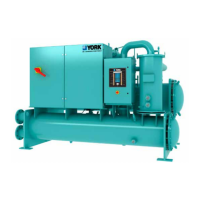JOHNSON CONTROLS
77
FORM 201.30-ICOM1 (519)
ISSUE DATE: 05/22/2019
5
SECTION 5 - COMMISSIONING
PREPARATION
Commissioning of this unit should only
be carried out by Johnson Controls au-
thorized personnel. Proper electrical lock
out/tag out procedures must be followed.
Make sure all checks are completed in the Start-up
Checklist (Form 201.30-CL3) on the next page. The
chiller is then ready to be placed into operation.
Commissioning personnel should be thoroughly fa-
miliar with the information contained in this document
before starting the unit.
For helpful tips about commissioning the unit, refer to
the following information.
Refrigerant Charge
Packaged units are normally shipped as standard with
a full refrigerant operating charge. Refer to the follow-
ing instructions to make sure the refrigerant is handled
correctly.
• Do not evacuate or liquid charge with static water
in the cooler or condenser.
• Turn the pumps on.
• Vapor charge until the system pressure is above
the saturated temperature for freezing of the uid
in the evaporator and condenser.
• Liquid charge slowly to avoid excessive thermal
stress at the charging point, and to make sure the
refrigerant temperature does not go below the
freezing point with liquid refrigerant in the evap-
orator and condenser.
• Evacuation and charging should always be done
according to SECTION 7 - MAINTENANCE.
Service and Oil Line Valves
If valves are of the back-seat type, open them fully
(counterclockwise), then close one turn of the stem.
Compressor Oil
While the compressor is running at design speed, the
oil level should be visible between the bottom of the
lower and middle of the upper sight glass of the oil
separator.
Make sure that the compressor heaters
have been energized at least 24 hours
before starting the chiller.
FIRST TIME START-UP
During the commissioning period, there
should be sufcient heat load to run the
unit under stable full load operation to
enable the unit controls, and system op-
eration to be set up correctly, and a com-
missioning log taken.
When a compressor is running, the controller monitors
oil pressure, motor current, and various other system
parameters, such as discharge pressure, chilled liquid
temperature, etc. Should any problems occur; the con-
trol system will immediately take appropriate action
and display the nature of the fault.
Loading
Once the unit has been started, all operations are fully
automatic. After an initial period at minimum capacity,
the control system will adjust the unit load depending
on the chilled liquid temperature and rate of tempera-
ture change. If a high heat load is present, the control-
ler will increase the speed of the compressor.

